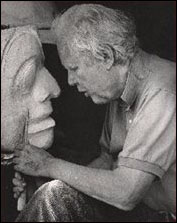THE SPIRIT CONCERT
A benefit concert for the Bill Reid Foundation
On 18 May 2002 Bruce will be participating in "The Spirit Concert" at the Chan Center in Vancouver, BC. a benefit concert in support of the Bill Reid Foundation. The following article will tell you why.
6 May 2002 --
'The land are the people and the people are the land.'
One of the central
human rights and environmental issues in Canada during the 80s was the
protection of the Gwaii Haanas
'Islands of Wonder' in the southern half of
Haida Gwaii
'Islands of the People', the homeland of the Haida Nation.

|
Haida Gwaii is also known as
The Queen Charlotte Islands,
British Columbia. |
Map courtesy of
www.virtualmuseum.ca
|
Burnaby Narrows is a shallow narrows between two islands, where the ocean is
concentrated and the area bathed in nutrients with each change of the tide.
It is positively stuffed with life; clams, anemones, starfish; a veritable
living sushi bar. You literally cannot walk anywhere without stepping on a
living thing. And the company wanted to build a log dump there. The Haida
Nation and many local residents said no and the logging company moved a bit
further north. There were planning teams and government promises and more
planning teams and proposals and more promises. But all the while, the
forests were still being logged. Finally the Haida Nation had enough and
blockaded the logging roads on Lyell Island, which got them arrested. And
the issue exploded.
I talked to Miles Richardson, 'Kilslikajisting', about Bruce's involvement. Miles is now Chief Commissioner for the British Columbia Treaty Commission and was the President of the Council of the Haida Nation during the campaign
for the protection of Gwaii Haanas. "The campaign was very expensive," he
said. "And we had to raise money. A supporter of the Haida Nation in
Toronto who knew Bruce approached him about helping us." And help Bruce did.
In 1986, he was just about to embark on a cross-Canada tour for the World of Wonders album. He donated his concert fees from the two Vancouver shows to the Haida Nation, a total of $35,000.
He also wrote Stolen Land
for the concerts. Later, Bruce came to Haida Gwaii and was recognized by the House
of the Assembly of the Haida Nation. He received a life-long invitation to
attend the House of the Assembly, the only person to ever receive such an
honour. Andy Wilson, who met Bruce at the airport and took him to the
Assembly, remembered Bruce's visit. "He was a real quiet guy. Then he
SANG." Of working with Bruce, Miles said, "We could trust him. That's
rare." Miles was one of speakers for Bruce's induction into the Juno Hall of Fame last March. Miles said "The Hall will be honoured with your presence."
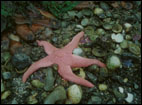
|
Burnaby Narrows-
"stuffed with life" |
| Photo - Mavis Mark. |
And in 1987, Gwaii Haanas was designated a National Park Reserve, to be
co-managed by the Haida Nation and Parks Canada. The Haida won. And Burnaby
Narrows is still stuffed with life.
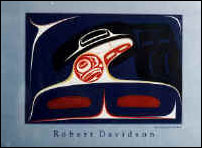 |
| Raven Bringing Light to the World |
Raven is trickster, transformer,
who never obeys the rules
and is always
getting into things,
sometimes causing trouble. |
Haida artist Robert Davidson also remembered the benefit concerts and Bruce's
visit to Haida Gwaii. In honour of Bruce's assistance to the Haida Nation,
Robert gave Bruce one of his prints "Every Other Salmon Has Come Back."
When it came time for a suitable cover for the next album, Waiting for a Miracle,
Robert had another painting, "Raven Bringing Light to the World" that he
thought "lent itself to an album" and he offered it to True North. They
accepted and own the original.
Central to the story of the Haida Nation is the story of Bill Reid. Bill is
one of Canada's greatest artists and brought the art of aboriginal peoples of
Northwest Coast to the international stage where it is now recognized as one
of the world's great artistic traditions. The Bill Reid Foundation, founded
to preserve his artistic legacy and teach the next generation their art and
traditions, is the beneficiary of the Spirit Concert.
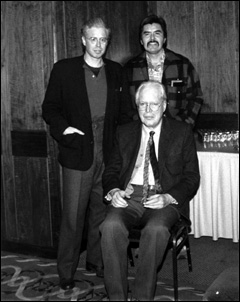
|
Bruce with Bill Reid (seated)
and Robert Davidson in 1986. |
Once again, the Haida
Nation has asked Bruce to help out. And again, he said yes. Robert Davidson
remembered Bruce and Bill Reid meeting in 1986. "They had a good rapport and
a good understanding of the issues. They were out of my league." Perhaps
two Ravens recognized each other as kindred spirits.
"Rum and guns and smallpox gonna change the face of home"
It is possible that Sir Walter Raleigh came to Haida Gwaii in the 1600s,
while on a secret mission for Elizabeth I, but the first known contact
between the Haidas and Europeans was in 1774. The Europeans were looking to
make their fortune. And in Haida Gwaii they found it - in sea otter pelts.
Once word got back to Europe of the rich pelts, many more ships came. The
Haidas, like all indigenous peoples, traded extensively, so commerce with
these strange New Comers at first was perhaps not so extraordinary. Sea
otter pelts were traded for metal objects, tools, blankets - and rum and
guns. However the voracious European appetite for pelts drove the sea otters
towards extinction. And in the 1860s, disaster struck when a smallpox
epidemic hit the coast, to which aboriginal peoples had no resistance.
Within two years, there were only about 300 Haida left from a population of
7000. Over 90% of the people died. And with them, all the songs, the
dances, the stories, the history, the knowledge they carried died too. In an
oral culture, knowledge isn't kept in books. It's kept in the people. The
library of Alexandria was burned by smallpox, not fire.
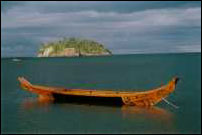
|
| lootaa - Bill's Carved Canoe |
Photo courtesy of
Mavis Mark
|
The survivors consolidated into two villages, Massett and Skidegate, leaving
the others by necessity. Next came the cultural explorers, the
anthropologists and gentlemen adventurers. With nobody left to protect the
old village sites, all manner of art and artifacts; masks, rattles, bentwood
boxes, totem poles; were carted off to museums around the world. It wasn't
just things. Graves were robbed and "human remains" taken for further study.
Sometimes the collectors saw themselves in a desperate race to preserve the
remnants of a dying culture. Others were looking for fame or fortune - or
both. Next, the settlers and missionaries came. Poles were cut down or
burnt as false idols and the Haidas were encouraged to convert to
Christianity. And the whalers came, and the miners, and the canneries and
the fishing boats and the logging companies.
"Kidnap all the children put 'em in a foreign system
Bring them up in no-man's land where no one really wants them"
Perhaps most devastating of all were the residential schools. Their legacy
still reverberates through all aboriginal societies today. The Canadian
government decided that the "best" thing they could do for the "dying red
race" was to teach the children to be white so they would have a future. So,
the government kidnapped the children and placed them in residential schools,
where they were isolated from their families and their people. They were
supposed to receive an education. Instead, they were physically and often
sexually abused. Young children were beaten for speaking their own language.
They were expected to forget who they were - and many did.
Then came Bill Reid.
Bill Reid was born in 1920, a dark time in the history of aboriginal peoples.
His mother was Haida and his father Scots-American. He didn't even know his
mother was Haida until he was a teenager.
In 1943, Bill first came to Haida Gwaii to meet his mother's relatives. His
grandfather was a boat builder and carver, and the nephew and apprentice of
Charles Edenshaw, the great 19th century carver and silversmith. His
grandfather showed him Edenshaw's work and Bill was fascinated. He began to
explore the structure of Haida design and experiment with European-style
jewelry making. In 1956, Bill was a CBC announcer. He read a news item about
a grant to recreate the totem poles and houses of a Haida village at the UBC
Museum of Anthropology. He turned off his mike, called the Museum, and
offered to help. The rest, as they say, is history.
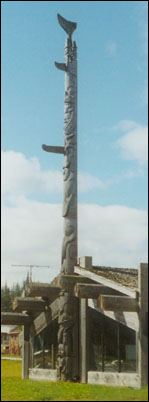
|
Bill Reid's pole
at the longhouse
in Skidegate. |
Photo courtesy of
Mavis Mark. |
The Haida village still stands today. At first, Bill had to learn Haida art by studying and copying objects in museum collections. Then he started to make new things - based in
the old traditions but new; gold bracelets, brooches, prints, carvings,
boxes, sculptures. He also started teaching others, most notably Robert
Davidson, the great grandson of Charles Edenshaw.
In 1969 Robert carved and raised the first pole in Massett in 80 years.
With the pole raising, the songs and dances were brought out again. And Bill kept making new things, and other artists began making new things. Bill raised the second pole, in
Skidegate, and he carved the first canoe in 50 years, Lootaa (Wave eater).
And the dancers needed new masks and blankets and the singers needed new
drums. Then there were new songs and dances.
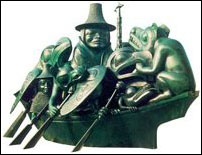
|
The sculpture -
The Spirit of Haida Gwaii
|
Photo courtesy of
Vancouver Airport site |
Perhaps Bill's crowning artistic achievement is his sculpture "The Spirit of
Haida Gwaii." It is a massive sculpture in bronze of a canoe stuffed with
his favourite characters. At over 6 m (20 feet) long, 4 m (13 feet) high and
3.5 m (12 feet) high and weighing 4900 kg (10,800 lb.), its creation was a
complex undertaking that took five years. There are two canoes, the Black
Canoe in the Canadian embassy in Washington DC and the Jade Canoe at the
airport in Vancouver BC.
[Bill Reid's description of the Spirit of Haida Gwaii]
Bill Reid kept the flame of Haida culture alive at its weakest, when it was
nearly extinguished, and breathed life into it. He brought the light back -
just like Raven.
"What step are you gonna take to set things right?"
'The land are the people and the people are the land.'
The fight for the land still continues. In British Columbia, most aboriginal peoples never
signed treaties so never legally gave up their rights to the land.
Successive governments have tried to ignore this fact, but the courts
increasingly are not. The most current manifestation is the BC's
government's treaty referendum, where voters are being asked to answer yes or
no to convoluted questions which are actually legal, not political in nature.
The Haida Nation recently won the appeal of a decision of a transfer of a
forest license between companies, which gives the company exclusive logging
rights to one-quarter of the forests of Haida Gwaii. The judge ruled that
the Haida should have been consulted before transferring the license. The
Province has maintained that aboriginal peoples must first prove their title
in court or negotiate a treaty before they will accommodate aboriginal title,
including when making decisions about land or resources. This position has
now been refuted. Old-growth forests, including cedar trees, are rightfully
referred to as the cornerstone of Haida culture. A canoe requires an
800-year old tree, while a totem pole requires a tree that is 400 - 500 years
old. The Haida Nation have long-standing concerns about industrial logging
in Haida Gwaii. There may be no cedar trees left for successive generations
of carvers and canoe makers.
The Haida Nation have also recently filed a lawsuit claming they are the
rightful owners of Haida Gwaii and the adjacent sea bed in Hectate Strait.
Because there is no treaty, the relationship between the Haida Nation and
Canada has never been established in law. There has been a moratorium on oil
exploration on the west coast for 30 years, but it may be lifted soon. The
east side of Haida Gwaii, Hectate Strait, is a prime candidate for potential
development, which the Haida Nation oppose. This time, the "sea otter pelts" are under the ocean floor.
'The Ancestors are coming home.'
The Haidas are repatriating the "human
remains" stored in museums around the world.
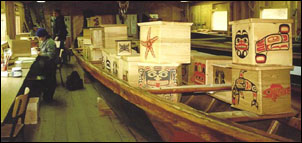
|
Terry Williams and Clifford Moody with
Lootaa filled with completed bent wood boxes.
The boxes are for the Ancestors. |
| Photo courtesy of Andy Wilson |
In 2000, they brought home 147 ancestors from the Museum of Civilization in Hull. "Well, it's really emotional because we are who we are because of these people," said Andy Wilson, chairman of the Skidegate Repatriation Committee. "We think about relatives. We think of them as people, not objects to be poked and prodded like the museum was doing. People are meant to be left alone when they are buried." A
bentwood box was made for each Ancestor. With the appropriate feasts and
ceremonies, they were returned home. There are still about 300 Ancestors in
museums in Chicago and New York and the Haida Nation are working on bring
them home, hopefully this fall. And there are still the art and artifacts
that were taken to bring home too. As Andy Wilson noted, the work isn't over
yet. "When we were able to go up to the other area of the museum and look at
the artifacts, the anger came back again, because there are thousands and
thousands. They're stacked to the ceiling. Anything and everything that was
in Haida households."
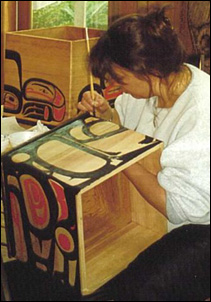
|
Sylvia Young from Skidegate,
painting bent wood boxes |
| Photo courtesy of Andy Wilson |
Haida art has been studied extensively, but traditional Haida music has not
received the same attention and effort. The Haida Nation, through the Song
Legacy Project, are working on developing educational resources for Haida
singers and preserving traditional songs and song protocol. These projects
include song workshops, digitally remastering the old recording of elders,
recording new songs, and creating a learning CD to teach the next generation
of singers.
And in school, the young people are learning Haida again.
"Stolen land - but it's all we've got"
Bill Reid passed away in 1998. His memorial at the UBC Museum of
Anthropology was a very good party, exactly as he would have wished. Speaker
after speaker told Bill Reid stories. Miles Richardson reminded us of Bill's
words. Bill had said, "In its essence, the word "Haida" means humans being." And in its essence, that's what the Spirit Concert will celebrate - being
human - our art, our expression of beauty; our music, our dance; from both
our traditions - First Nations and New Comers - just as Bill Reid created his
"well-made objects" from both traditions.
The Bach Choir will present Bruce Ruddell's choral work, "Spirit of Haida
Gwaii", Bill Reid's words set to music.
The Rainbow Creek Dancers will be presenting Haida dances and songs, both new and traditional. Songs and dances are rarely performed for a public audience.
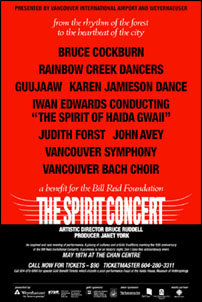
|
| Poster for "The Spirit Concert". |
Karen Jamieson will present a new work of modern dance.
And of course, Bruce will be singing too.
Despite the history of brutality of one people to another in this Stolen
Land, we can still come together in celebration and enrich each other with
our different cultural traditions. In that, is our hope. Besides, isn't
this what being Canadian is? Bruce said "-- what it is that makes us feel
like Canadians is something in our hearts that is really hard to define. It's
there though." In his music is the connection to the land and integration of
cultures that is quintessentially Canadian, although like Bruce, I can't
explain why. In the Spirit Concert, it's there too.
Perhaps our task as former Europeans is to become good relatives and stop
messing the place up. We need to stop moving on to the next supply of sea
otters or timber or fish or oil, and recognize it is our home too.
'The
land are the people and the people are the land.' First Nations or New
Comers, none of us can live without the land. Like Bill Reid's companions
packed into the canoe, we're all in this together. Yes, there is still much
work ahead, but we can celebrate too. Think how far the canoe has already
come.
It promises to be a magic evening.
"The Spirit Concert" will be held on May 18th at the Chan Centre, Vancouver BC.
Tickets are available through
www.ticketmaster.ca and CBC-TV will tape the concert for future broadcast.
Related Links
Bill Reid Foundation
Haida art and artists at the Canadian Museum of Civilization
Canadian Museum of Civilization
How-aa (Thank you) to Terri-Lynn Williams-Davidson, Robert Davidson, Audrey
Gill, Miles Richardson and Andy Wilson for the background information and to Mavis Mark for the photos.
Audrey Pearson, has been back and forth
to Haida Gwaii since 1988.
Concert/show review by Audrey.
News Index
This page is part of The Cockburn Project, a unique website that exists to document the work of Canadian singer-songwriter and musician Bruce Cockburn. The Project archives self-commentary by Cockburn on his songs and music, and supplements this core part of the website with news, tour dates, and other current information.






